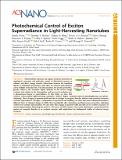Notice
This is not the latest version of this item. The latest version can be found at:https://dspace.mit.edu/handle/1721.1/136083.2
Photochemical Control of Exciton Superradiance in Light-Harvesting Nanotubes
| dc.contributor.author | Doria, Sandra | |
| dc.contributor.author | Sinclair, Timothy S | |
| dc.contributor.author | Klein, Nathan D | |
| dc.contributor.author | Bennett, Doran IG | |
| dc.contributor.author | Chuang, Chern | |
| dc.contributor.author | Freyria, Francesca S | |
| dc.contributor.author | Steiner, Colby P | |
| dc.contributor.author | Foggi, Paolo | |
| dc.contributor.author | Nelson, Keith A | |
| dc.contributor.author | Cao, Jianshu | |
| dc.contributor.author | Aspuru-Guzik, Alán | |
| dc.contributor.author | Lloyd, Seth | |
| dc.contributor.author | Caram, Justin R | |
| dc.contributor.author | Bawendi, Moungi G | |
| dc.date.accessioned | 2021-10-27T20:30:44Z | |
| dc.date.available | 2021-10-27T20:30:44Z | |
| dc.date.issued | 2018 | |
| dc.identifier.uri | https://hdl.handle.net/1721.1/136083 | |
| dc.description.abstract | Photosynthetic antennae and organic electronic materials use topological, structural, and molecular control of delocalized excitons to enhance and direct energy transfer. Interactions between the transition dipoles of individual chromophore units allow for coherent delocalization across multiple molecular sites. This delocalization, for specific geometries, greatly enhances the transition dipole moment of the lowest energy excitonic state relative to the chromophore and increases its radiative rate, a phenomenon known as superradiance. In this study, we show that ordered, self-assembled light-harvesting nanotubes (LHNs) display excitation-induced photobrightening and photodarkening. These changes in quantum yield arise due to changes in energetic disorder, which in turn increases/decreases excitonic superradiance. Through a combination of experiment and modeling, we show that intense illumination induces different types of chemical change in LHNs that reproducibly alter absorption and fluorescence properties, indicating control over excitonic delocalization. We also show that changes in spectral width and shift can be sensitive measures of system dimensionality, illustrating the mixed 1-2D nature of LHN excitons. Our results demonstrate a path forward for mastery of energetic disorder in an excitonic antenna, with implications for fundamental studies of coherent energy transport. | |
| dc.language.iso | en | |
| dc.publisher | American Chemical Society (ACS) | |
| dc.relation.isversionof | 10.1021/ACSNANO.8B00911 | |
| dc.rights | Article is made available in accordance with the publisher's policy and may be subject to US copyright law. Please refer to the publisher's site for terms of use. | |
| dc.source | Other repository | |
| dc.title | Photochemical Control of Exciton Superradiance in Light-Harvesting Nanotubes | |
| dc.type | Article | |
| dc.relation.journal | ACS Nano | |
| dc.eprint.version | Author's final manuscript | |
| dc.type.uri | http://purl.org/eprint/type/JournalArticle | |
| eprint.status | http://purl.org/eprint/status/PeerReviewed | |
| dc.date.updated | 2019-09-19T12:29:05Z | |
| dspace.orderedauthors | Doria, S; Sinclair, TS; Klein, ND; Bennett, DIG; Chuang, C; Freyria, FS; Steiner, CP; Foggi, P; Nelson, KA; Cao, J; Aspuru-Guzik, A; Lloyd, S; Caram, JR; Bawendi, MG | |
| dspace.date.submission | 2019-09-19T12:29:08Z | |
| mit.journal.volume | 12 | |
| mit.journal.issue | 5 | |
| mit.metadata.status | Authority Work and Publication Information Needed |
